Remembering Lebbeus Woods 1940-2012
I still remember vividly the moment during the Rendering Speculations Conference that I co-organized at the Architectural Association in 2010, Lebbeus being broadcast live from NY from a 50 inch LG monitor asking repeatedly ‘Where is Zaha?’. Organized as an afternoon discussion on how drawings and the act of design permeates architectural representation and speculation, Tobias Klein and I, who is both a friend and co-organizer, had planned an event that would trigger an alternative to the sterile diagrammatic over-strategic architectural template in vogue at the time. That wasn’t my first encounter with Lebbeus, but it was the first time that I realized that behind one of my all-time ‘favourite architects’ there was also a personality shaped by an educator as a core principia. His clarity of thought and thinking pattern was less based on lowering complex conversations to the lowest common denominator than to trust the audience to engage with his concerns, or his projects problematic, and the cosmology of those concerns, from extreme site conditions to populations under siege and the role of the architect. Under his scrutinous command of language he elaborated arguments so intensely that there would not be a stone unturned and a fact misspelled. He meant his words. He also meant that those chosen words would not generate consensus, but debate. Lebbeus explored his ideas not as definitive conclusions to diverse questions, but rather as a starting point and foundation to inspire. During the conference while describing the awe inspiring ‘Aerial Paris’ project he said:
“As an architect I have never been interested in dictating a final form, I am more interested in mobilizing a set of possibilities that others could take up, I am still waiting for some architects to take up Aerial Paris in their projects…”
I remember very well when we first got the news that The Hanging Cemetery of Baghdad project of NaJa & deOstos would be printed by RIEA – edited by Lebbeus and Guy Lafranche – and our second book Pamphlet Architecture 29: Ambiguous Spaces would have the honour of a feature introduction by Lebbeus Woods. In both instances the projects were fundamentally not only inspired by Lebbeus, but among other things, conceived as a reaction to his world. A world similar to a scientific mind-set where assumptions are not enough, but elaboration and practice matures an idea into a project. It was also a reaction to a world, like in fiction and literature, where ambiguity is not mistaken as lack of clarity but an open invitation for potential completions, participation and deliverance into and from the work. It is however, a vast world abundant with architectural anti-panoramas, ideal city propositions and radical environmental reconstructions that form a world-like system of exploration.
The work generated a gravity of its own kind; attracting subjects, context and form into its extra-ordinary projective field. When one looks at Lebbeus’s drawings, writings and body of work, the so called ‘thesis’ of an architect’s career – the consistency on which one pursues the goals that he/she/they placed on their horizon as a challenge of sorts – becomes dwarfed and petti, simply because one is faced with a force of intention where rules are re-created not followed as a career path. Here the educator is less the one who masticates and delivers, but one that provokes a natural arrogance approach to challenges that are not solvable by a curriculum, a year or prizes. Lebbeus work is a long term challenge. When the XVII century philosopher Gottfried Wilhelm Leibniz became greatly offended when he found out his Master Tutor gave him tasks that have already been solved and proved in the 17th century, he not only assumed its role on the path of his education, but from then onwards developed questionings of his own calibre in line with the challenges of his time that ultimately became the foundations for his production of work on calculus and philosophy. My impression, and it is only an impression, is that Lebbeus created his Tour the Force portfolio by an adherence to the principle rather than strategy; both self-initiated projects and commissions.
On March the 3rd 2012 I met Lebbeus at his flat in New York to interview him for an upcoming publication of our academic work at the Architectural Association. After several exchanges via emails, phone calls, Skype conferences it was the first time we met. He gave one hour of his time from where we unrolled a conversation about contextual response and design as an active tool of social speculation. Here again he was a man of his word where even when denying the creation of a total project and advocating individual case problems and responses, he divulged how he constructed a set of strong references to explain his architecture and most importantly to think about the challenges laid by his work.
In the interview he mentioned:
‘We should aim to make work that cannot be digestible, therefore stays alive…’
The power of his projects is driven by fantastic drawings that occasionally may have obfuscated the rich ambiguity of Lebbeus Woods work. A work developed not by a utopian idealist but by a man in search of his relation to a world where some problems are to be solved while others are to be re-solved. While looking at the book ‘War and Architecture’ beside my desk I feel that the only way to finish this text is to thank Lebbeus for the work he will still generate through his legacy in a world shaken by not only wars and social crisis but also elasticated with hope and stewardess from a time when giants walked the earth.
Ricardo de Ostos





